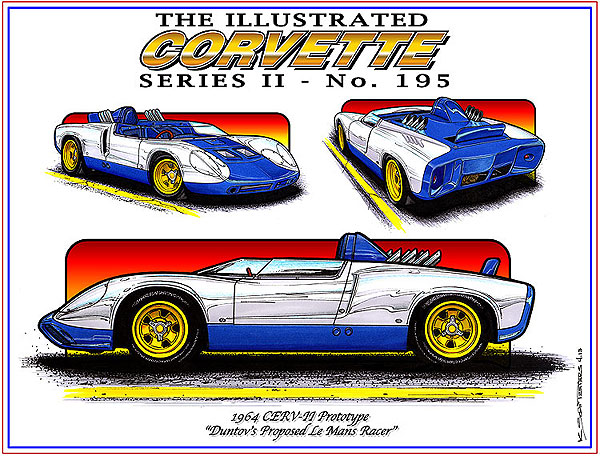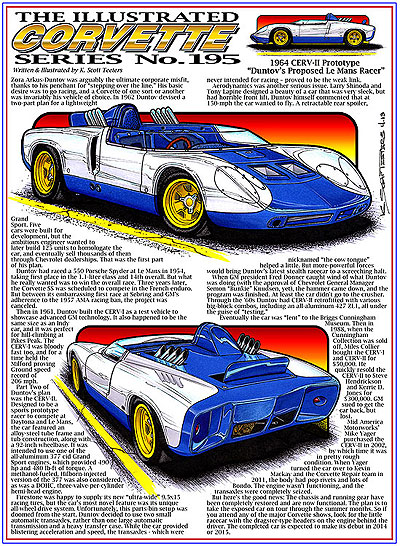The 1964 AWD CERV II – Duntov’s planned Ford GT40-Killer and Le Mans Champion.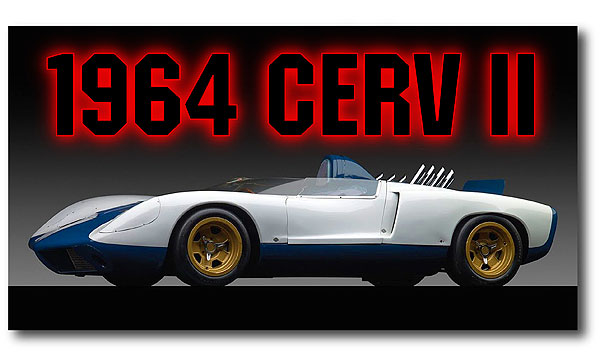 Dateline: 11.23.17 – For decades the topic of a mid-engine Corvette was simply “pie in the sky.” It was a fanciful piece of Corvette lore going back to the early days when Zora Arkus-Duntov was driving the Corvette brand. Every so many years, the topic would resurface, so when I heard it again for the umpteenth time, just after the C7 arrived, I said, “Oh, sure…” But, it’s going to happen, finally! The mid-engine C8 Corvette will make its grand debut at the 2018 North American International Auto Show in Detroit as a 2019 model.
Dateline: 11.23.17 – For decades the topic of a mid-engine Corvette was simply “pie in the sky.” It was a fanciful piece of Corvette lore going back to the early days when Zora Arkus-Duntov was driving the Corvette brand. Every so many years, the topic would resurface, so when I heard it again for the umpteenth time, just after the C7 arrived, I said, “Oh, sure…” But, it’s going to happen, finally! The mid-engine C8 Corvette will make its grand debut at the 2018 North American International Auto Show in Detroit as a 2019 model.
 In the interest of explaining how we got to where we are with the whole, long, mid-engine Corvette story, lets buckle into the Corvette Report Time Machine, set the dials (yes, we still use “dials” here at Corvette Report) and go back to 1963/1964 when that wiley, silver-haired Russian fox, Zora Arkus-Duntov tried once again, to build a “Corvette” to race at Le Mans. Indulge me while I bench race a little here,but if the CERV II, with its all-wheel-drive, fuel-injected, mid-engine design could have been properly developed, there might have been a Corvette of two, or three in the winner’s circle at Le Mans in 1966. 1964, here we come!
In the interest of explaining how we got to where we are with the whole, long, mid-engine Corvette story, lets buckle into the Corvette Report Time Machine, set the dials (yes, we still use “dials” here at Corvette Report) and go back to 1963/1964 when that wiley, silver-haired Russian fox, Zora Arkus-Duntov tried once again, to build a “Corvette” to race at Le Mans. Indulge me while I bench race a little here,but if the CERV II, with its all-wheel-drive, fuel-injected, mid-engine design could have been properly developed, there might have been a Corvette of two, or three in the winner’s circle at Le Mans in 1966. 1964, here we come!
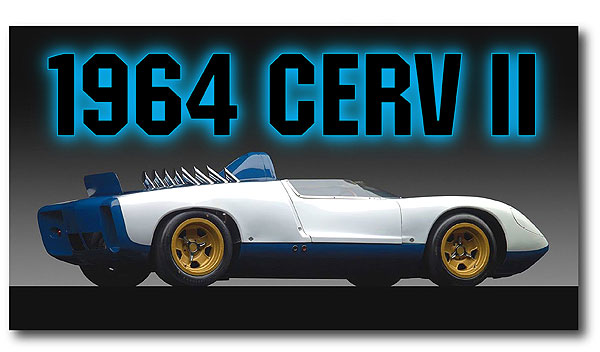 There’s a new metric in the world of performance sports cars called “The Two-Second Club.” Members include the Nissan GT-R, Porsche 918 Spyder, the Ferrari 458 Special, and the 2016 Z06 Corvette. A good gauge of a car’s baseline performance is 0-to-60 and quarter-mile times. The Nissan GT-R, was the first production performance car to break into the “2-second” zone in 2012. The GT-R packs a 530-hp twin turbo V8 and an all-wheel drive system. All-wheel-drive has been around since the 1890s and the first “official” AWD car was the 1903 Spyker. With the exception for a few race cars, AWD/4WD was relegated to heavy trucks, Jeeps, and later rugged-terrain off-road vehicles.
There’s a new metric in the world of performance sports cars called “The Two-Second Club.” Members include the Nissan GT-R, Porsche 918 Spyder, the Ferrari 458 Special, and the 2016 Z06 Corvette. A good gauge of a car’s baseline performance is 0-to-60 and quarter-mile times. The Nissan GT-R, was the first production performance car to break into the “2-second” zone in 2012. The GT-R packs a 530-hp twin turbo V8 and an all-wheel drive system. All-wheel-drive has been around since the 1890s and the first “official” AWD car was the 1903 Spyker. With the exception for a few race cars, AWD/4WD was relegated to heavy trucks, Jeeps, and later rugged-terrain off-road vehicles.
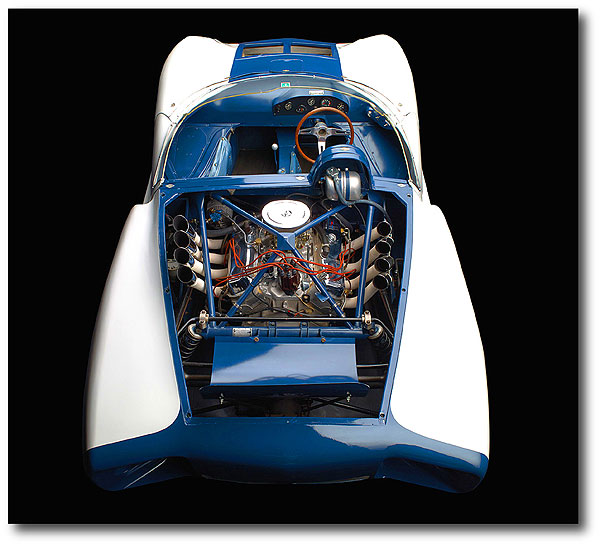 Zora Arkus-Duntov was greatly influenced by the Auto Union and Mercedes race cars of the pre and post WW II era of racing. AWD was often part of the advanced engineering of the world’s best race cars, so it was no surprise that Duntov wanted AWD in his Corvette prototype to race at Le Mans. “Getting there” in a company that makes consumer cars would be a challenge, so Zora was limited to the parts bin. Duntov built his AWD racer using a 2-speed Powerglide automatic transmission with a modified 11-inch torque converter for the rear wheels, and a Corvair Powerglide transmission with a modified 10-inch torque converter just ahead of the front wheel centerline. There are many ways of driving four wheels in an automobile, but this was so unique that on November 19, 1968 Duntov was awarded U.S. Patient #3,411,601 for the design.
Zora Arkus-Duntov was greatly influenced by the Auto Union and Mercedes race cars of the pre and post WW II era of racing. AWD was often part of the advanced engineering of the world’s best race cars, so it was no surprise that Duntov wanted AWD in his Corvette prototype to race at Le Mans. “Getting there” in a company that makes consumer cars would be a challenge, so Zora was limited to the parts bin. Duntov built his AWD racer using a 2-speed Powerglide automatic transmission with a modified 11-inch torque converter for the rear wheels, and a Corvair Powerglide transmission with a modified 10-inch torque converter just ahead of the front wheel centerline. There are many ways of driving four wheels in an automobile, but this was so unique that on November 19, 1968 Duntov was awarded U.S. Patient #3,411,601 for the design.
Duntov’s CERV II featured an alloy-steel tube frame and tub construction, with a 92-inch wheelbase. Fuel cells were mounted in the sides. Torsion tests on the frame showed that that the structure was below par – only 2,000-pound-feet per degree, so a tubular X-brace was added over the engine to get the torsion level up to 5,000-pound-feet per degree. This was a big improvement but well below that of the Ford GT40 that had 12,500-pound-feet per degree. Had the CERV II been fully developed the frame and structure would have most likely been redesigned. Brakes were four-wheel experimental vented disc brakes.
 Zora planned to use one of three possible engines: either of the all-aluminum 490 hp / 480 lb-ft of torque 377-cid Grand Sport engine, or a methanol-fueled, Hilborn-injected version of the 377, or a DOHC, three-valve-per-cylinder hemi-head version! Radiators were mounted just ahead of the rear wheels on both sides. All four Kelsey-Hayes 15×8 magnesium knock-off wheels were shod with the latest Firestone “ultra-wide” 9.5×15 racing tires.
Zora planned to use one of three possible engines: either of the all-aluminum 490 hp / 480 lb-ft of torque 377-cid Grand Sport engine, or a methanol-fueled, Hilborn-injected version of the 377, or a DOHC, three-valve-per-cylinder hemi-head version! Radiators were mounted just ahead of the rear wheels on both sides. All four Kelsey-Hayes 15×8 magnesium knock-off wheels were shod with the latest Firestone “ultra-wide” 9.5×15 racing tires.
Unfortunately, the parts-bin AWD setup was doomed from the start. While the car provided blistering acceleration and speed on the test track, the transaxles – which were never intended for racing, proved to be the weak link. At GM’s Milford Proving Ground, using an alcohol-fueled all-aluminum experimental 377 small-block engine, Zora drove the CERV II to a top speed of 214-mph!
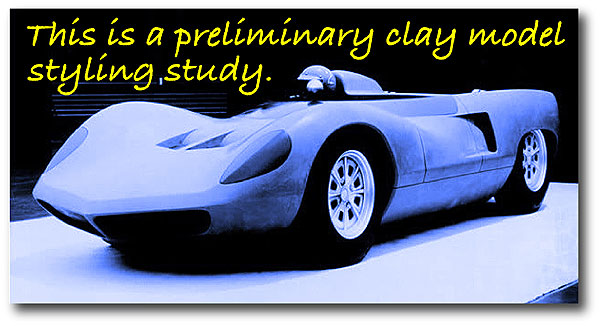 Aerodynamics was another serious issue. Larry Shinoda and Tony Lapine designed sleek car, but it had horrible front lift. The lower portion of the front of the car was the culprit, as it was allowing too much air to go under the car, thus causing serious front-end lift at high speed. The C2 Sting Ray and the C3 Corvette had the same design issue. Compare a side-view of the CERV II, a C2 Sting Ray, and a C3 Mako Shark-style Corvette to a modern C5, C6, and C7 Corvette and the cause of the problem is obvious – too much air being allowed under the front of the car. Duntov even commented that at 150-mph the car… “The car wanted to fly!” (That must have been fun!) A retractable rear spoiler, nicknamed the “cow tongue” was added and helped a little. But forces more powerful than aerodynamic lift would bring Duntov’s machine to a screeching halt.
Aerodynamics was another serious issue. Larry Shinoda and Tony Lapine designed sleek car, but it had horrible front lift. The lower portion of the front of the car was the culprit, as it was allowing too much air to go under the car, thus causing serious front-end lift at high speed. The C2 Sting Ray and the C3 Corvette had the same design issue. Compare a side-view of the CERV II, a C2 Sting Ray, and a C3 Mako Shark-style Corvette to a modern C5, C6, and C7 Corvette and the cause of the problem is obvious – too much air being allowed under the front of the car. Duntov even commented that at 150-mph the car… “The car wanted to fly!” (That must have been fun!) A retractable rear spoiler, nicknamed the “cow tongue” was added and helped a little. But forces more powerful than aerodynamic lift would bring Duntov’s machine to a screeching halt.
When GM president Fred Donner caught wind of what Duntov and Chevrolet General Manager Semon Knudsen were up to, the hammer came down. Fortunately, the CERV II went into storage and not the crusher. (Perhaps GM’s brass secretly liked the CERV II?) Another interesting factoid is that the CERV II’s final R&D budget, including final engineering and tooling was $1,250,000! That’s almost $10 million in 2016 dollars,
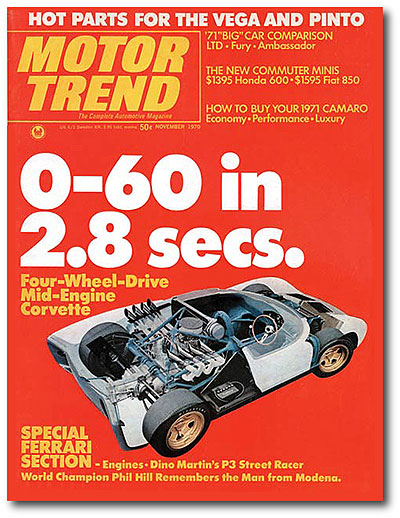 Through the ‘60s’ Duntov had the CERV II retrofitted with various engine combos, including an all-aluminum 427 ZL-1, all under the guise of “testing.” The CERV II showed up on the cover of the November 1970 issue of Motor Trend with the headline, “0-60 in 2.8 secs.” The claim was dubious because the article states, “…calculations showed that with a low final drive ratio the CERV would accelerate from 0-60 in 2.8 seconds with a maximum of 115-mph.” Note the operative word there, “calculations.” In contrast, the same Motor Trend issue tested the Honda 600 and Fiat 850. Remember those? (Zzzz…)
Through the ‘60s’ Duntov had the CERV II retrofitted with various engine combos, including an all-aluminum 427 ZL-1, all under the guise of “testing.” The CERV II showed up on the cover of the November 1970 issue of Motor Trend with the headline, “0-60 in 2.8 secs.” The claim was dubious because the article states, “…calculations showed that with a low final drive ratio the CERV would accelerate from 0-60 in 2.8 seconds with a maximum of 115-mph.” Note the operative word there, “calculations.” In contrast, the same Motor Trend issue tested the Honda 600 and Fiat 850. Remember those? (Zzzz…)
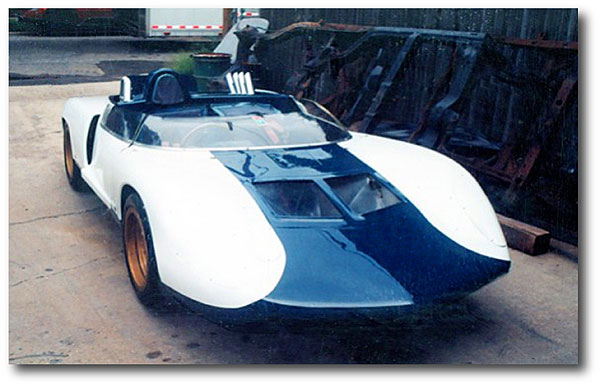 Regardless, a 1,900-pound car with 600-plus horsepower and AWD is going to be mighty quick. In 1973 more details about the CERV II surfaced in Karl Ludvigsen’s book, “CORVETTE America’s Star Spangled Sports Car” in Chapter 18 – Mid-Engine XP-Machines.” After the splash in Ludvigsen’s book, little attention was paid to the once contender for a planned Le Mans assault by Duntov.
Regardless, a 1,900-pound car with 600-plus horsepower and AWD is going to be mighty quick. In 1973 more details about the CERV II surfaced in Karl Ludvigsen’s book, “CORVETTE America’s Star Spangled Sports Car” in Chapter 18 – Mid-Engine XP-Machines.” After the splash in Ludvigsen’s book, little attention was paid to the once contender for a planned Le Mans assault by Duntov.
Years later the car was “on loan” to the Briggs Cunningham Museum, but in 1988, when the collection was sold off, Miles Collier bought the CERV-I and CERV II for $50,000, then quickly resold the CERV II to Steve Hendrickson and Kerrie D. Jones for $300,000. GM sued to get the car back, but lost. In 2011 the then current owner hired Corvette restoration expert, Kevin Mackay, owner of Corvette Repair in Valley Stream, New York to get the CERV II back into running condition.
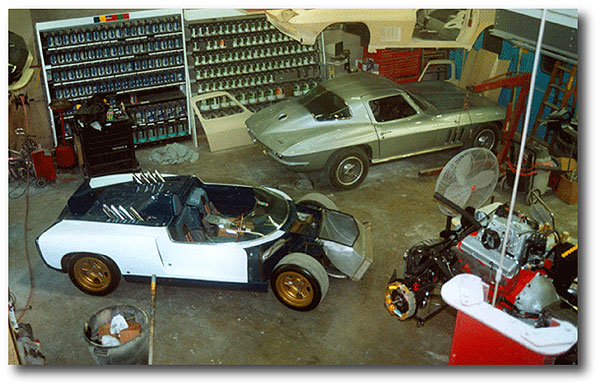 By the time the CERV II arrived in Mackay’s shop, it was in sad condition. Mackay said, “It was a 50-foot beauty. There were bumps in the paint and pop rivets covered with bondo. When you closed the door, the car shook. It was mechanically as bad as it looked because it hadn’t been running in a long time. The transmission system was completely seized tight. We had a heck-of-a-time, but we fixed the car and made it look right.” While the CERV II never raced, it kept the mid-engine concept alive and as we’ll see, many more mid-engine Corvettes were to come.
By the time the CERV II arrived in Mackay’s shop, it was in sad condition. Mackay said, “It was a 50-foot beauty. There were bumps in the paint and pop rivets covered with bondo. When you closed the door, the car shook. It was mechanically as bad as it looked because it hadn’t been running in a long time. The transmission system was completely seized tight. We had a heck-of-a-time, but we fixed the car and made it look right.” While the CERV II never raced, it kept the mid-engine concept alive and as we’ll see, many more mid-engine Corvettes were to come.
 The most recent development on the CERV II was in November 2013 when the car sold at the RM New York Auction for $1,000,000! Any time a car sells at that level it’s an “event,” but the pre-auction estimates on the sale price of the car were between $1,400,000 and $1,800,000. Even still, the CERV II is now a “Million Dollar Car.” Duntov never would have imagined that. All he wanted to do was race and win at Le Mans! – Scott
The most recent development on the CERV II was in November 2013 when the car sold at the RM New York Auction for $1,000,000! Any time a car sells at that level it’s an “event,” but the pre-auction estimates on the sale price of the car were between $1,400,000 and $1,800,000. Even still, the CERV II is now a “Million Dollar Car.” Duntov never would have imagined that. All he wanted to do was race and win at Le Mans! – Scott
Coming up Next! The 1964 CORVETTE GS-II – Corvette Engineering Meets Jim Hall’s Chaparral
You can purchase the below CERV-II 11×17 art print of the below signed and numbered by the artist from our safe, secure Amazon store for just $29.95, plus $6.95 S&H, HERE! Or, just click the below images.


